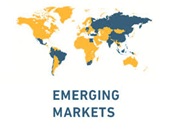Investing in emerging markets amid today’s complex global landscape presents both opportunities and risks. Can investors identify markets with a strong potential for risk-adjusted returns? Can they avoid the worst of the pitfalls? In a webinar on March 19, 2025, three experts in the field presented a round-table discussion titled “Capital Flows, Tariffs & Trade: A Defining Moment for Emerging Markets Investors.”
They touched on issues as wide-ranging as exchange rates, geopolitical risk, and trade barriers that will be discussed more fully at the upcoming conference, CFA Institute LIVE 2025 to be held in Chicago, 4-7 May, 2025.
The panel moderator, Cynthia Steer, (left side of graphic) is a recognized independent board member and global investment industry leader. She noted that, as an asset class, the emerging markets seem to be “all over the place.” As two recent examples, she cited February’s strong rally in the Colombian stock market and the recent decline in Taiwan’s stock.
Although emerging markets suffer from concentration risk and volatility, the stocks tend to be cheaper, and there is more growth potential.
Jon Spinney (center of graphic), CIO for the pension fund Vestcor, said emerging markets did not become an asset class until the late 1990s. He agreed there is a dichotomy of returns. However, for the past 15 years, the top performers have been one of the emerging markets, or a frontier market.
Dianna Raedelle (right side of graphic), CEO, President and Founder at the Deere Isle Group, pointed out the connection between currency and markets. The USD has been appreciating against emerging markets. Observers wonder whether the USD will stay as strong as it has been in the past. Investor behavior affects the sizable dichotomy between countries, so it’s important that investors analyze the source of economic growth.
Spinney noted the significant change in emerging markets. China’s first-place position among BRICS nations has been outpaced by India’s strong economic growth. There’s been a recent shift in private equity allocation toward India.
Raedelle said other countries such as Mexico and Nigeria have grown faster than BRICS, so there are more places to put the investor’s dollar.
Steer commented on the current renewed focus on tariffs, interest rates, and balance of payments. The World Bank and the International Monetary Fund are training members to take digital currencies.
Raedelle said the U.S. interest in cryptocurrency will reverberate through the world economy. “In terms of the ease of global flow, do we need the friction of all these different currencies?”
In April, significant tariffs around aluminum and steel fabrication are scheduled to go into effect. Tariffs will hit each country differently, and the savvy investor needs to understand which sectors will outperform among the emerging markets. As well, “which countries have a proven track record of negotiating with the U.S.?” Spinney asked. “It’s a wait-and-see approach.”
Steer noted that in private markets, infrastructure development has elicited interest. “Smaller development-oriented investments are more controllable and have better returns.”
Raedelle agreed that companies catering to the internal economy will benefit.
Spinney said that millions of people in emerging market countries are now joining the middle class. Thus, there is a shift to the consumer-driven economy.
Generally, investments in infrastructure are good. “Population growth is driving infrastructure projects,” Spinney said. The informal Mar-a-Lago accord is aimed at devaluing the U.S. dollar to address trade imbalances and increase American economic competitiveness.
Steer said the spheres of influence among nations were changing. “We cannot assume the same kinds of relationships as before.”
The U.S. economy is still 25 percent of the world economy. In 2000, Spinney noted the U.S. featured in 75 percent of the deals; now they feature in 60 percent of the deals. “The U.S. still remains the economy of choice, but there will be increasing pockets of opposition.”
Raedelle said, “We are seeing more trade not going through the U.S.” The Gulf Cooperation Council (GCC), containing Bahrain, Kuwait, Oman, Qatar, Saudi Arabia, and the United Arab Emirates, is becoming a viable trading bloc, as well as India.
The panelists emphasized investors needed to spend time learning about the impact of changes in emerging markets in order to gain excess returns. They discussed capital flow in the emerging markets, and whether research & development will continue apace.
Steer posed the question, “Why is China still considered an emerging market?”
“It’s a large economy but there’s investor hesitation due to the governance,” Spinney said.
Raedelle agreed. “China has severe capital controls; therefore it’s seen as an emerging market.”
Eventually panelists reached a consensus. There will be choppiness in emerging markets, but there are pockets of opportunity and thus economic growth remains quite strong. ♠️
Click here to register for the upcoming conference, CFA Institute LIVE 2025 to be held in Chicago, 4-7 May, 2025.
The BRICS graphic is from the Signium website. Permission pending.



